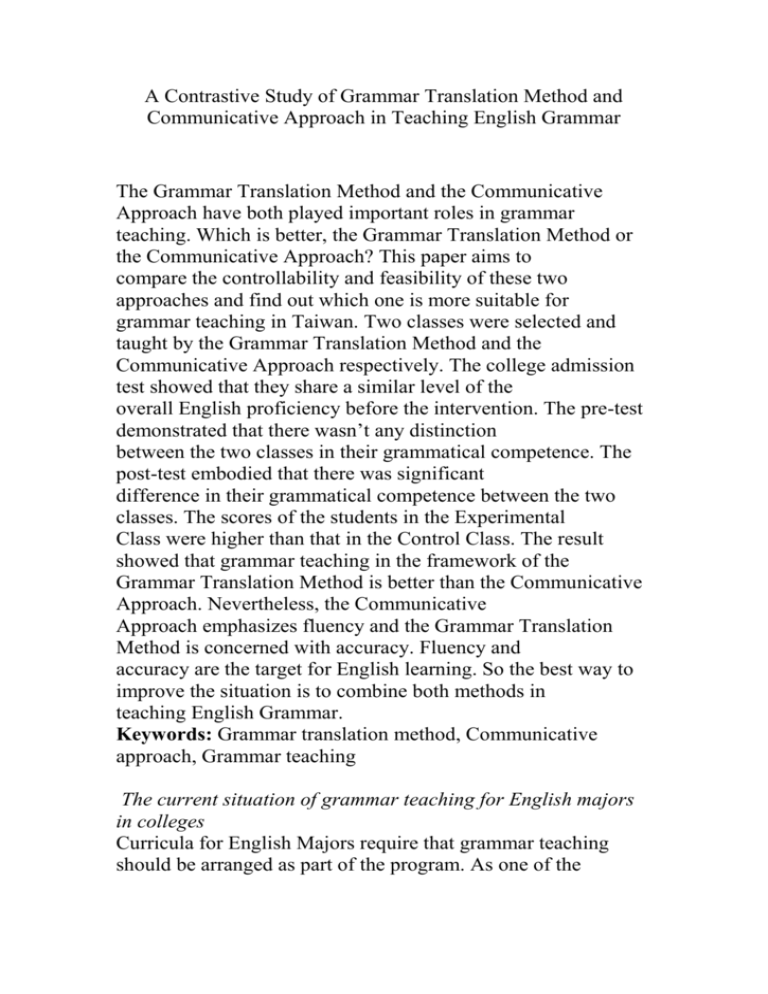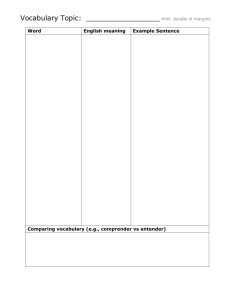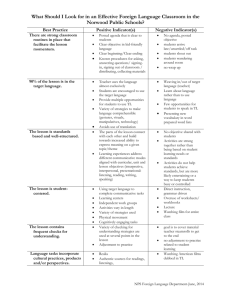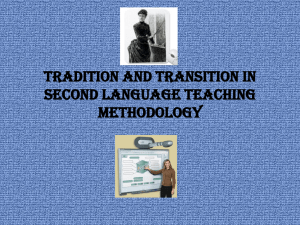The current situation of grammar teaching for English majors in
advertisement

A Contrastive Study of Grammar Translation Method and Communicative Approach in Teaching English Grammar The Grammar Translation Method and the Communicative Approach have both played important roles in grammar teaching. Which is better, the Grammar Translation Method or the Communicative Approach? This paper aims to compare the controllability and feasibility of these two approaches and find out which one is more suitable for grammar teaching in Taiwan. Two classes were selected and taught by the Grammar Translation Method and the Communicative Approach respectively. The college admission test showed that they share a similar level of the overall English proficiency before the intervention. The pre-test demonstrated that there wasn’t any distinction between the two classes in their grammatical competence. The post-test embodied that there was significant difference in their grammatical competence between the two classes. The scores of the students in the Experimental Class were higher than that in the Control Class. The result showed that grammar teaching in the framework of the Grammar Translation Method is better than the Communicative Approach. Nevertheless, the Communicative Approach emphasizes fluency and the Grammar Translation Method is concerned with accuracy. Fluency and accuracy are the target for English learning. So the best way to improve the situation is to combine both methods in teaching English Grammar. Keywords: Grammar translation method, Communicative approach, Grammar teaching The current situation of grammar teaching for English majors in colleges Curricula for English Majors require that grammar teaching should be arranged as part of the program. As one of the required courses, grammar has been taught to English majors in universities and colleges for years. It is known that “grammar is a set of rules that define how words (or parts of words) are combined or changed to form acceptable units of meaning within a language” . Guaranteeing the accuracy of the sentences mainly depends on the learner’s mastery of grammar. Grammar, which is an indispensable part of a language, is so important that the teachers and students have always attached great importance to grammar teaching and learning. For the above-mentioned reasons, how to make grammar teaching and learning effective and efficient is an important task for both English teachers and researchers. Although college English teaching and learning research in Taiwan has undergone great changes during the past decades. The current grammar teaching in colleges is still characterized by the adoption of the traditional teaching method, which is known as the Grammar Translation Method. With this model, language structures are presented by the teacher, then practiced in the form of spoken or written exercises, and then used by the learners in less controlled speaking or writing activities. Although the traditional grammar teaching method helps improve the students’ mastery of the grammatical rules, the students cannot use these rules flexibly and appropriately in communication. That is to say, the traditional grammar teaching method has its disadvantages which prevent the students from developing their communicative competence. Firstly, the traditional grammar teaching method is teacher-centered. As a result, the majority of the classroom time is spent on the teachers’ elaborate explanation of English grammar rules, while all the students are either listening or taking notes. Thus little attention is paid to the development of English communicative competence. The students accept the English knowledge passively in the procedures set ahead of time by English teachers step by step. There is little use of the English language. The typical exercise is to translate sentences from English into Taiwanese or vice versa, to fill in the blank with a proper word and to correct errors in a sentence. So the students lack English communicative opportunities. Secondly, memorization and rote learning are the basic learning techniques, which cannot help to arouse students’ interest, build their self-confidence or improve their communicative strategies in English learning and even makes them fear English grammar learning. An alternative to the traditional grammar teaching method is the Communicative Approach. The Communicative Approach makes language teaching as in real-world situation. Grammar learning is emphasized by communication through the approaches of ‘learning by doing’, through students’ participation or co-operative completion of teaching tasks between or among students and teachers, then grammar can be acquired naturally by learners For decades, English grammar teaching in Taiwan has been greatly influenced by some traditional teaching methods, such as the Grammar Translation Method, the Direct Method, and the Audio-Lingual Method. The Communicative Language Teaching or Communicative Approach was introduced into Taiwan in the late 1970s. Fostering the communicative competence is its central goal. Communicative competence is concerned not only with what is grammatical but what is appropriate in a given social situation. Hymes (1972) proposes that language should betaught in communicative situations in order for learners to achieve communicative competence. Learners should not only be equipped with language knowledge, but also be capable of appropriately using the foreign language in various situations. However, it has been gradually assumed among the scholars and teachers in Taiwan that communicative competence makes the ultimate objective of English Language teaching, and the Communicative Approach, if completely and well conceived, does not involve the rejection of grammar. On the contrary, it involves recognition of its central mediating role in the use and learning of language . What Englishlanguage teaching in Taiwan counts is to make a good negotiation between the traditional and modern teachingmethod; to make a proper conception of communicative competence and develop a flexible communicative way toformal instruction in the� classroom. What is called grammatical competence has been regarded as a significantcomponent of learner’s communicative competence by many linguists . In addition, theups-and-downs of ELT in Taiwan in recent decades has given us reflection on it. Many Taiwanese scholars andexperts have discussed and confirmed the possibilities of the combination of the Grammar Translation Method and the Communicative Approach and there is a growing comeback of the role of grammatical instruction in the classroom. Based on the notion of communicative competence and the significant role of grammar teaching, this paper aim to find out which one (Communicative Approach and Grammar Translation Method) is more suitable for grammar teaching in College education in Taiwan









